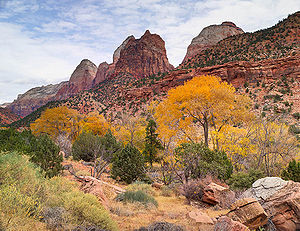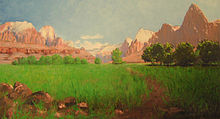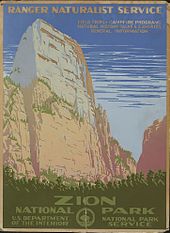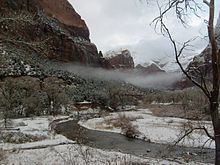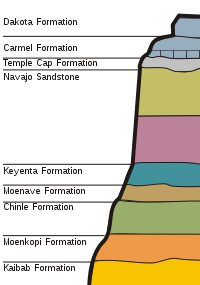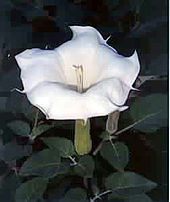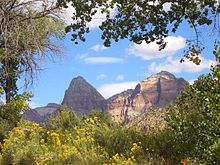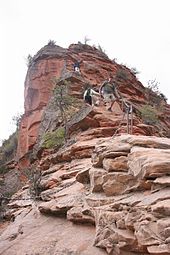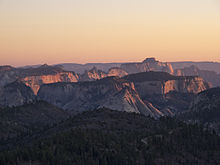- Zion National Park
-
Zion National Park IUCN Category II (National Park)Location Washington, Kane, and Iron counties, Utah, United States Nearest city Springdale, Utah(south), Orderville, Utah (east) and Cedar City, Utah near Kolob Canyons entrance Coordinates 37°12′09″N 112°59′16″W / 37.20262°N 112.98785°WCoordinates: 37°12′09″N 112°59′16″W / 37.20262°N 112.98785°W Area 146,597 acres (59,326 ha)[1] Established July 31, 1909 Visitors 2,665,972 (in 2010)[2] Governing body National Park Service  Zion Canyon as seen from the top of Angels Landing at sunset
Zion Canyon as seen from the top of Angels Landing at sunset
Zion National Park is located in the Southwestern United States, near Springdale, Utah. A prominent feature of the 229-square-mile (590 km2) park is Zion Canyon, which is 15 miles (24 km) long and up to half a mile (800 m) deep, cut through the reddish and tan-colored Navajo Sandstone by the North Fork of the Virgin River. The lowest elevation is 3,666 ft (1,117 m) at Coalpits Wash and the highest elevation is 8,726 ft (2,660 m) at Horse Ranch Mountain. Located at the junction of the Colorado Plateau, Great Basin, and Mojave Desert regions, the park's unique geography and variety of life zones allow for unusual plant and animal diversity. Numerous plant species as well as 289 species of birds, 75 mammals (including 19 species of bat), and 32 reptiles inhabit the park's four life zones: desert, riparian, woodland, and coniferous forest. Zion National Park includes mountains, canyons, buttes, mesas, monoliths, rivers, slot canyons, and natural arches.
Human habitation of the area started about 8,000 years ago with small family groups of Native Americans; the semi-nomadic Basketmaker Anasazi (300 CE) stem from one of these groups. In turn, the Virgin Anasazi culture (500 CE) developed as the Basketmakers settled in permanent communities.[3] A different group, the Parowan Fremont, lived in the area as well. Both groups moved away by 1300 and were replaced by the Parrusits and several other Southern Paiute subtribes. The canyon was discovered by Mormons in 1858 and was settled by that same group in the early 1860s. In 1909, U.S. President William Howard Taft named the area a National Monument to protect the canyon, under the name of Mukuntuweap National Monument. In 1918, however, the acting director of the newly created National Park Service changed the park's name to Zion as the original name was locally unpopular. Zion is one of the names of Jerusalem in ancient Hebrew. The United States Congress established the monument as a National Park on November 19, 1919. The Kolob section was proclaimed a separate Zion National Monument in 1937, but was incorporated into the park in 1956.
The geology of the Zion and Kolob canyons area includes 9 formations that together represent 150 million years of mostly Mesozoic-aged sedimentation. At various periods in that time warm, shallow seas, streams, ponds and lakes, vast deserts, and dry near-shore environments covered the area. Uplift associated with the creation of the Colorado Plateaus lifted the region 10,000 feet (3,000 m) starting 13 million years ago.[4]
Contents
Geography and climate
The park is located in southwestern Utah in Washington, Iron, and Kane counties. Geomorphically, it is located on the Markagunt and Kolob plateaus, at the intersection of three North American geographic provinces: the Colorado Plateaus, the Great Basin, and the Mojave Desert. The northern part of the park is known as the Kolob Canyons section and is accessible from Interstate 15, exit 40.[5]
The 8,726-foot (2,660 m) summit of Horse Ranch Mountain (photo) is the highest point in the park; the lowest point is the 3,666-foot (1,117 m) elevation of Coal Pits Wash, creating a relief of about 5,100 feet (1,600 m).[6]
Streams in the area take rectangular paths because they follow jointing planes in the rocks.[7] The stream gradient of the Virgin River, whose North Fork flows through Zion Canyon in the park, ranges from 50 to 80 feet (15 to 24 m) per mile (0.9–1.5%)—one of the steepest stream gradients in North America.[8]
The road into Zion Canyon is 6 miles (9.7 km) long, ending at the Temple of Sinawava ("Sinawava" refers to the Coyote God of the Paiute Indians).[9] At the Temple the canyon narrows and a foot-trail continues to the mouth of the Zion Narrows, a gorge as narrow as 20 feet (6 m) wide and up to 2,000 feet (610 m) tall.[10] The Zion Canyon road is served by a free shuttle bus from early April to late October and by private vehicles the other months of the year. Other roads in Zion are open to private vehicles year-round.
The east side of the park is served by the Zion–Mount Carmel Highway, which passes through the Zion–Mount Carmel Tunnel and ends at Mount Carmel Junction, Utah. On the east side of the park notable park features include Checkerboard Mesa (photo) and the East Temple.
The Kolob Terrace area west of Zion Canyon features The Subway, a slot canyon hike, and Lava Point, with a panoramic view of the entire area. The Kolob Canyons section, further west near Cedar City, features one of the world's longest arches, Kolob Arch.[11]
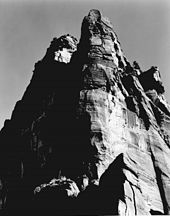 Zion rock formation, photo c. 1941 by Ansel Adams
Zion rock formation, photo c. 1941 by Ansel Adams
Zion National Park Climate chart (explanation) J F M A M J J A S O N D 1.652291.657311.763361.373430.783520.693600.8100681.697660.89160178491.263371.55330Average max. and min. temperatures in °F Precipitation totals in inches Source: ZNP Metric conversion J F M A M J J A S O N D 4111-24114-1431723323618281115341620382041361920331625269301733812-1Average max. and min. temperatures in °C Precipitation totals in mm Spring weather is unpredictable, with stormy, wet days being common, mixed with occasional warm, sunny weather. Precipitation is heaviest in March.[12] Spring wildflowers bloom from April through June, peaking in May. Fall days are usually clear and mild; nights are often cool. Summer days are hot (95 °F to 110 °F; 35 °C to 43 °C), but overnight lows are usually comfortable (65 °F to 70 °F; 18 °C to 21 °C).[12] Afternoon thunderstorms are common from mid-July through mid-September.[12] Storms may produce waterfalls as well as flash floods. Autumn tree-color displays begin in September in the high country; inside Zion Canyon, autumn colors usually peak in late October. Winter in Zion Canyon is fairly mild. Winter storms bring rain or light snow to Zion Canyon and heavier snow to the higher elevations. Clear days may become quite warm, reaching 60 °F (16 °C); nights are often 20 °F (−7 °C) to 40 °F (4 °C) .[12] Winter storms can last several days and make roads icy. Zion roads are plowed, except the Kolob Terrace Road which is closed when covered with snow.[12] Winter driving conditions last from November through March.[12]
Notable geographical features of the park include: Virgin River Narrows, Emerald Pools (photo), Hidden Canyon (photo), Angels Landing (photo), The Great White Throne, Checkerboard Mesa (photo), The Three Patriarchs (photo) and Kolob Arch.
Human history
Archaeologists have divided the long span of Zion's human history into three cultural periods: the Archaic, Protohistoric and Historic periods. Each period is characterized by distinctive technological and social adaptations.
Archaic period
The first human presence in the region dates to 8,000 years ago when family groups camped where they could hunt or collect plants and seeds.[13] About 2,000 years ago, some groups began growing corn and other crops, leading to an increasingly sedentary lifestyle.[14] Later groups in this period built permanent villages called pueblos. Archaeologists call this the Archaic period and it lasted until about 500 CE.[15] Baskets, cordage nets, and yucca fiber sandals have been found and dated to this period. The Archaic toolkits included flaked stone knives, drills, and stemmed dart points. The dart points were attached to wooden shafts and propelled by throwing devices called atlatls.[15]
By 300 CE some of the archaic groups developed into an early branch of seminomadic Anasazi, the Basketmakers.[15] Basketmaker sites have grass- or stone-lined storage cists and shallow, partially underground dwellings called pithouses. They were hunters and gatherers who supplemented their diet with limited agriculture. Locally collected pine nuts were important for food and trade.
Protohistoric period
 Kaun huts were used by Southern Paiute
Kaun huts were used by Southern Paiute
Both the Virgin Anasazi and the Parowan Fremont disappear from the archaeological record of southwestern Utah by about 1300.[15] Extended droughts in the 11th and 12th centuries, interspersed with catastrophic flooding, may have made horticulture impossible in this arid region.[15]
Tradition and archaeological evidence hold that their replacements were Numic-speaking cousins of the Virgin Anasazi, such as the Southern Paiute and Ute.[15] The newcomers migrated on a seasonal basis up and down valleys in search of wild seeds and game animals.[16] Some, particularly the Southern Paiute, also planted fields of corn, sunflowers, and squash to supplement their diet.[16] These more sedentary groups made brownware vessels that were used for storage and cooking.[15]
Exploration and settlement by Euro-Americans
The Historic period begins in the late 18th century[15] with the exploration of southern Utah by Padres Silvestre Vélez de Escalante and Francisco Atanasio Domínguez. The padres passed near what is now the Kolob Canyons Visitor Center on October 13, 1776, becoming the first people of European descent known to visit the area.[17] In 1825, trapper and trader Jedediah Smith explored some of the downstream areas while under contract with the American Fur Company.[17]
In 1847, Mormon farmers from the Salt Lake area became the first people of European descent to settle the Virgin River region.[8] In 1851, the Parowan and Cedar City, Utah areas were settled by Mormons who used the Kolob Canyons area for timber, and for grazing cattle, sheep, and horses.[18] They prospected for mineral deposits, and diverted Kolob water to irrigate crops in the valley below. Mormon settlers named the area Kolob—in Mormon scripture, the heavenly place nearest the residence of God.[19]
Settlements had expanded 30 miles (48 km) south to the lower Virgin River by 1858.[8] That year, a Southern Paiute guide led young Mormon missionary and interpreter Nephi Johnson into the upper Virgin River area and Zion Canyon.[17] Johnson wrote a favorable report about the agricultural potential of the upper Virgin River basin, and returned later that year to found the town of Virgin. In 1861 or 1862, Joseph Black made the arduous journey to Zion Canyon and was very impressed by its beauty.[3]
The floor of Zion Canyon was settled in 1863 by Isaac Behunin, who farmed corn, tobacco, and fruit trees.[3] The Behunin family lived in Zion Canyon near the site of today's Zion Lodge during the summer, and wintered in Springdale. Behunin is credited with naming Zion, a reference to a place of peace mentioned in the Bible.[3] Two more families settled Zion Canyon in the next couple of years, bringing with them cattle and other domesticated animals. The canyon floor was farmed until Zion became a Monument in 1909.[8]
The Powell Geographic Expedition entered the area in 1869 after their first trip through the Grand Canyon.[8] John Wesley Powell visited Zion Canyon in 1872 and named it Mukuntuweap, under the impression that that was the Paiute name.[20] Powell Survey photographers John K. Hillers and James Fennemore first visited the Zion Canyon and Kolob Plateau region in the spring of 1872.[8] Hillers returned in April 1873 to add more photographs to the "Virgin River Series" of photographs and stereographs.[21] Hillers described wading the canyon for four days and nearly freezing to death to take his photographs.[21]
Protection and tourism
Paintings of the canyon by Frederick S. Dellenbaugh were exhibited at the St. Louis World's Fair in 1904,[8] followed by a glowing article in Scribner's Magazine the next year. That, along with previously created photographs, paintings, and reports, led to U.S. President William Howard Taft's proclamation on July 31, 1909 that created Mukuntuweap National Monument.[17] In 1917, the acting director of the newly created National Park Service visited the canyon and proposed changing its name to Zion from the locally unpopular Mukuntuweap.[22] The United States Congress added more land and established Zion National Park on November 19, 1919.[3] A separate Zion National Monument, the Kolob Canyons area, was proclaimed on January 22, 1937, and was incorporated into the park on July 11, 1956.[23]
Travel to the area before it was a national park was rare due to its remote location, lack of accommodations, and the absence of real roads in southern Utah. Old wagon roads were upgraded to the first automobile roads starting about 1910, and the road into Zion Canyon was built in 1917, to as far as The Grotto.[15]
Touring cars could reach Zion Canyon by the summer of 1917.[15] The first visitor lodging in Zion Canyon, called Wylie Camp, was established that same year as a tent camp.[15] The Utah Parks Company, a subsidiary of the Union Pacific Railroad, acquired Wylie Camp in 1923, and offered ten-day rail/bus tours to Zion, nearby Bryce Canyon, Kaibab, and the North Rim of the Grand Canyon.[24] The Zion Lodge complex was built in 1925 at the site of the Wylie tent camp.[15] Architect Gilbert Stanley Underwood designed Zion Lodge (photo) in the "Rustic Style" and the Utah Parks Company funded the construction.[15]
Work on the Zion–Mount Carmel Highway started in 1927 to enable reliable access between Springdale and the east side of the park.[3] The road opened in 1930 and park visitation and travel in the area greatly increased.[25] The most famous feature of the highway is the 1.1-mile (1.8 km) Zion - Mt. Carmel Tunnel, which has six large windows cut through the massive sandstone cliff.[8]
In 1896, local rancher John Winder improved the Native American footpath up Echo Canyon, which later became the East Rim Trail.[26] Entrepreneur David Flanigan used this trail in 1900 to build cableworks that lowered lumber into Zion Canyon from Cable Mountain. More than 200,000 board feet (470 m3) of lumber were lowered by 1906.[26] The auto road was extended to the Temple of Sinawava, and a trail built from there 1 mile (2 km) to the start of the Narrows.[27] Angel's Landing Trail was constructed in 1926 and two suspension bridges were built over the Virgin River.[20] Other trails were constructed by the Civilian Conservation Corps during the 1930s.[20]
More recent history
Zion Canyon Scenic Drive provides access to Zion Canyon. Traffic congestion in the narrow canyon was recognized as a major problem in the 1990s and a public transportation system using propane-powered shuttle buses was instituted in the year 2000.[28] As part of its shuttle fleet, Zion has two electric trams each holding up to 36 passengers.[29] From April through October, the scenic drive in Zion Canyon is closed to private vehicles and visitors ride the shuttle buses.[28]
On April 12, 1995, heavy rains triggered a landslide that blocked the Virgin River in Zion Canyon.[30] Over a period of two hours, the river carved away part of the only exit road from the canyon, trapping 450 guests and employees in the Zion Lodge.[30] A one-lane temporary road was constructed within 24 hours to allow evacuation of the Lodge.[30] A more stable—albeit temporary—road was completed on May 25, 1995 to allow summer visitors to access the park.[30] This road was replaced with a permanent road during the first half of 1996.[30]
The Zion–Mount Carmel Highway can be traveled year-round. Access for over-sized vehicles requires a special permit, and is limited to daytime hours, as traffic through the tunnel must be one way to accommodate large vehicles. The 5-mile (8.0 km)-long Kolob Canyons Road was built to provide access to the Kolob Canyons section of the park.[31] This road often closes in the winter.
In March 2009, President Barack Obama signed into law the Omnibus Public Land Management Act of 2009, which designated and further protected 124,406 acres (503.5 km2) of park land as the Zion Wilderness.
Geology
Main article: Geology of the Zion and Kolob canyons area The Three Patriarchs in Zion Canyon are made of Navajo Sandstone.
The Three Patriarchs in Zion Canyon are made of Navajo Sandstone.
The nine known exposed geologic formations in Zion National Park are part of a super-sequence of rock units called the Grand Staircase. Together, these formations represent about 150 million years of mostly Mesozoic-aged sedimentation in that part of North America. The formations exposed in the Zion area were deposited as sediment in very different environments:
- The warm, shallow (sometimes advancing or retreating) sea of the Kaibab and Moenkopi formations;
- Streams, ponds, and lakes of the Chinle, Moenave, and Kayenta formations;
- The vast desert of the Navajo and Temple Cap formations; and
- The dry near-shore environment of the Carmel Formation.
 The Kolob Canyons are a set of finger canyons cut into the Kolob Plateau.
The Kolob Canyons are a set of finger canyons cut into the Kolob Plateau.
Uplift affected the entire region, known as the Colorado Plateaus, by slowly raising these formations more than 10,000 feet (3,000 m) higher than where they were deposited.[32] This steepened the stream gradient of the ancestral Virgin and other rivers on the plateau.
The faster-moving streams took advantage of uplift-created joints in the rocks. Eventually, all Cenozoic-aged formations were removed and gorges were cut into the plateaus. Zion Canyon was cut by the North Fork of the Virgin River in this way. During the later part of this process, lava flows and cinder cones covered parts of the area.[33]
High water volume in wet seasons does most of the downcutting in the main canyon. These flood events are responsible for transporting most of the 3 million short tons (2.7 million metric tons) of rock and sediment that the Virgin River transports yearly.[8] The Virgin cuts away its canyon faster than its tributaries can cut away their own streambeds, so tributaries end in waterfalls from hanging valleys where they meet the Virgin.[8] The valley between the peaks of the Twin Brothers is a notable example of a hanging valley in the canyon.
Table of formations exposed in Zion National Park[34] Rock layer Appearance Location Deposition Rock type Photo Dakota Formation Cliffs Top of Horse Ranch Mountain Streams Conglomerate and sandstone 
Carmel Formation Cliffs Mt Carmel Junction Shallow sea and coastal desert Limestone, sandstone and gypsum 
Temple Cap Formation Cliffs Top of West Temple Desert Sandstone 
Navajo Sandstone Steep cliffs 1,600 to 2,200 ft (490 to 670 m) thick; red lower layers are colored by iron oxides
Tall cliffs of Zion Canyon; highest exposure is West Temple. Cross-bedding shows well at Checkerboard Mesa (photo) Desert sand dunes covered 150,000 sq mi (390,000 km2). Shifting winds during deposition created cross-bedding Sandstone 
Kayenta Formation Rocky slopes Throughout canyon Streams Siltstone and sandstone 
Moenave Formation Slopes and ledges Lower red cliffs seen from Zion Human History Museum Streams and ponds Siltstone and sandstone 
Chinle Formation Purplish slopes Above Rockville Streams Shale, loose clay and conglomerate 
Moenkopi Formation Chocolate cliffs with white bands Rocky slopes from Virgin to Rockville Shallow sea Shale, siltstone, sandstone, mudstone, and limestone 
Kaibab Formation Cliffs Hurricane Cliffs along I-15 near Kolob Canyons Shallow sea Limestone 
Biology
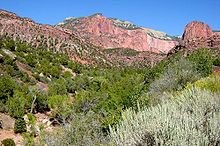 Taylor Creek with Horse Ranch Mountain in background. Desert, riparian, woodland, and coniferous forest habitats are all visible.
Taylor Creek with Horse Ranch Mountain in background. Desert, riparian, woodland, and coniferous forest habitats are all visible.
The Great Basin, Mojave Desert, and Colorado Plateau converge at Zion and the Kolob canyons.[35] This, along with the varied topography of canyon–mesa country, differing soil types, and uneven water availability, provides diverse habitat for the equally diverse mix of plants and animals that live in the area. The park is home to 289 bird, 79 mammals, 28 reptiles, 7 fish, and 6 amphibian species.[36] These organisms make their homes in one or more of four life zones found in the Park: desert, riparian, woodland, and Coniferous forest.[37]
Desert conditions persist on canyon bottoms and rocky ledges away from perennial streams. Sagebrush, Prickly pear Cactus, and Rabbitbrush, along with Sacred Datura and Indian Paintbrush, are common.[38] Utah Penstemon and Golden Aster can also be found.[39] Milkvetch and Prince's Plume are found in pockets of selenium-rich soils.[37]
Common daytime animals include Mule Deer, Rock Squirrels, Pinyon Jays, and Whiptail and Collared lizards (photo). Desert Cottontails,[40] Jackrabbits, and Merriam's Kangaroo Rats come out at night. Cougars, Coyotes, Gray Foxes, and Ring-tail Cats are the top predators.[40]
Cooler conditions persist at mid-elevation slopes, from 3,900 to 5,500 feet (1,200 to 1,700 m).[37] Stunted forests of pinyon pine and Juniper coexist here with manzanita shrubs, cliffrose, serviceberry, Scrub Oak, and yucca.[37] Stands of Ponderosa Pine, Gambel Oak, manzanita and aspen populate the mesas and cliffs above 6,000 feet (1,800 m).[37]
Golden Eagles, Red-tailed Hawks, Peregrine Falcons, and White-throated Swifts can be seen in the area.[41] California Condors and Bighorn Sheep were introduced in the 1990s. Nineteen species of bat also live in the area.[42]
Boxelder, Fremont Cottonwood, maple, and willow dominate riparian plant communities.[37] Animals such as Bank Beavers, Flannel-mouth Suckers, Gnatcatchers, Dippers, Canyon Wrens, the Virgin Spinedace, and Water Striders all make their homes in the riparian zones.[43]
Activities
Driving through the east side of Zion to U.S. Route 89 allows access to Bryce Canyon National Park in the north or to the north rim of the Grand Canyon in the south. Due to the narrowness of the Zion–Mount Carmel Tunnel, RVs and buses must obtain a special pass and can only drive through the tunnel during limited hours.[44]
The more primitive sections of Zion include the Kolob Terrace and the Kolob Canyons. The Grotto in Zion Canyon, the Visitor Center, and the viewpoint at the end of Kolob Canyons Road have the only designated picnic sites.[6]
Seven popular trails with round-trip times of half an hour (Weeping Rock) to 4 hours (Angels Landing) are found in Zion Canyon.[45] Two popular trails, Taylor Creek (4 hours round trip) and Kolob Arch (8 hours round trip), are in the Kolob Canyons section of the park, near Cedar City.[45]
Hiking up into The Narrows (Zion National Park) from the Temple of Sinawava is popular in summer. Orderville Canyon, a narrower slot canyon, is also popular. Backpacking down The Narrows from the top takes 12 hours.[46] Other often-used backcountry trails include the West Rim and LaVerkin Creek.[47]
Zion is a center for rock climbing, with short walls like Touchstone, Moonlight Buttress, Spaceshot, and Prodigal Son being very popular.[48]
Lodging in the park is available at Zion Lodge, located halfway through Zion Canyon. Zion Lodge is open year-round and has motel units and cabins, as well as a restaurant, café, and gift shop, but rooms fill up fast. Three campgrounds are available: South and Watchman at the far southern side of the park, and a primitive site at Lava Point in the middle of the park off Kolob Terrace Road.[49] Watchman is the only campground in the park that takes reservations. Lava Point has only primitive facilities and is usually open from June to October.[49] Overnight camping in the backcountry requires permits.[50]
Guided horseback riding trips, nature walks, and evening programs are available from late March to early November.[51] The Junior Ranger Program for ages 6 to 12 is active from Memorial Day to Labor Day at the Zion Nature Center.[52]
Rangers at the Zion Canyon Visitor Center and the smaller Kolob Canyons Visitor Center can help visitors plan their stay. A bookstore attached to the Zion Canyon Visitor Center, run by the Zion Natural History Association, offers books, maps, and souvenirs for sale, with proceeds benefiting the park.[53]
Adjacent to the park on the south is the town of Springdale, Utah, which offers services such as lodging, food, and entertainment. Zion Canyon IMAX in Springdale offers many interesting documentaries about the natural history of Zion Canyon and the American Southwest. Lodging, food, and entertainment are also offered on the east side of the park along the Zion–Mount Carmel Highway and in Mount Carmel Junction.
References
 This article incorporates public domain material from websites or documents of the National Park Service.
This article incorporates public domain material from websites or documents of the National Park Service.
 This article incorporates public domain material from websites or documents of the United States Geological Survey.
This article incorporates public domain material from websites or documents of the United States Geological Survey.- ^ "Listing of acreage as of 12/31/2010". Public Use Statistic Office, National Park Service. http://www.nature.nps.gov/stats/Acreage/acrebypark10cy.pdf. Retrieved 2011-06-08.
- ^ "Five Year Annual Recreation Visits Report". Public Use Statistic Office, National Park Service. http://www.nature.nps.gov/stats/viewReport.cfm?selectedReport=SystemComparisonReport.cfm. Retrieved 2011-06-08.
- ^ a b c d e f Tufts 1998, p. 45
- ^ Tufts 1998, p. 43
- ^ NPS website, How to get here
- ^ a b NPS website, Accessibility
- ^ Harris 1997, p. 33
- ^ a b c d e f g h i j Harris 1997, p. 29
- ^ Alexander, Charles P (January 1948). "Records and Descriptions of North American Crane-Flies (Diptera). Part VII. The Tipuloidea of Utah". American Midland Naturalist (The University of Notre Dame) 39 (1): 1–82. doi:10.2307/2421428. JSTOR 2421428.
- ^ NPS website, Zion Narrows (archive)
- ^ NPS website, Freestanding Arches
- ^ a b c d e f NPS website, Weather and Climate
- ^ NPS website, History and Culture
- ^ NPS website, Archeology (archive)
- ^ a b c d e f g h i j k l m NPS website, People
- ^ a b NPS website, Human History (archive)
- ^ a b c d Kiver 1999, p. 457
- ^ Arrington, Leonard J.. "Colonization of Utah". Utah History Encyclopedia. Salt Lake City, Utah: State of Utah. http://historytogo.utah.gov/utah_chapters/pioneers_and_cowboys/colonizationofutah.html. Retrieved January 18, 2009.
- ^ NPS contributors (Summer 2008). "Zion Map and Guide" (PDF). Washington, D.C.: National Park Service. http://www.nps.gov/zion/planyourvisit/upload/Zion%20Map%20&%20Guide%20summer%202008.pdf. Retrieved January 18, 2009.
- ^ a b c Powell, Allen Kent (1996). "Zion National Park". Utah History Encyclopedia. Salt Lake City, Utah: University of Utah Press. http://www.media.utah.edu/UHE/z/ZIONPARK.html. Retrieved on January 1, 2009.
- ^ a b USGS contributors. "Virgin River Canyons: Historic 3D Photographs of Powell Survey in the Zion National Park Area". In Stoffer, Phil. Washington, D.C.: United States Geological Survey. Archived from the original on June 1, 2008. http://web.archive.org/web/20080601032614/http://3dparks.wr.usgs.gov/3Dcanyons2/html/virgin.htm. Retrieved January 18, 2009. (public domain text)
- ^ Albright, Horace M.; Schenck, Marian Albright; Utley, Robert M. (1999). "18 - Exploring a New World of Parks, 1917" (PDF). Creating the National Park Service: The Missing Years. University of Oklahoma Press, Norman Publishing. p. 243. http://www.nps.gov/history/history/online_books/albright2/pdf/ch18.pdf. Retrieved January 18, 2009.
- ^ "Appendix C" (pdf). Leave No Trace Principles. Washington, D.C.: National Park Service.
- ^ (PDF) Cape Royal Road. Washington, D.C.: National Park Service. after 1968. p. 4. HAER AZ-40. http://lcweb2.loc.gov/pnp/habshaer/az/az0300/az0358/data/az0358.pdf. Retrieved January 18, 2009.
- ^ NPS website, The Zion–Mount Carmel Tunnel
- ^ a b ZNHA contributors. A Guide to the Trails: Zion National Park. Springdale, Utah: Zion Natural History Association. http://alumnus.caltech.edu/~leif/camping/AGuideToTheTrailsOfZion.html. Retrieved January 18, 2009.
- ^ Kiver 1999, p. 465
- ^ a b NPS website, Green Transit - The Zion Shuttle
- ^ "Zion Traffic Mitigation Report, Department of Transportation". United States Department of Transportation, Federal Highway Administration. http://ops.fhwa.dot.gov/publications/mitig_traf_cong/zion_park_case.htm. Retrieved 2009-12-19.
- ^ a b c d e Mentz, Kevin M.; Worrell, Eric; Zanetell, F. Dave (1997). "Park Project Is a Paragon of Partnership". Public Roads (Federal Highway Administration, United States Department of Transportation) 60 (4). http://www.tfhrc.gov/pubrds/spring97/zion.htm. Retrieved on January 18, 2009.
- ^ Kona, Srividya. "Zion National Park, Utah". Travel. Texas Tech University. http://www.utdallas.edu/~sxk038200/travel/ZionNationalPark.html. Retrieved January 1, 2009.
- ^ Kiver 1999, p. 461
- ^ Harris 1997, p. 42
- ^ NPS contributors. "Geology Fieldnotes: Zion National Park". Washington, D.C.: National Park Service. http://www2.nature.nps.gov/geology/parks/zion/#geology. Retrieved January 1, 2009. (public domain text and table)
- ^ NPS website, Home page
- ^ NPS contributors. "Wilderness Stewardship Plan Handbook" (doc). Washington, D.C.. p. 31. http://www.nps.gov/zion/parkmgmt/upload/ZION%20BC%20Plan.doc. Retrieved December 20, 2008.
- ^ a b c d e f Leach 2007, p. 39
- ^ NPS website, Plants (subpages)
- ^ NPS website, Wildflowers
- ^ a b NPS website, Animals (subpages)
- ^ NPS website, Bird list
- ^ NPS website, Mammal list
- ^ Leach 2007, p. 40
- ^ NPS website, Fees & Reservations
- ^ a b NPS website, Day Hiking (archive)
- ^ NPS website, Zion Narrows
- ^ NPS contributors (2008) (PDF). Backcountry Planner. Washington, D.C.: National Park Service. p. 10. http://www.nps.gov/zion/planyourvisit/upload/Zion_BC_Planner_08.pdf. Retrieved January 18, 2009.
- ^ NPS website, Backcountry Reservations and Permits (archive)
- ^ a b NPS website, Campgrounds
- ^ NPS website, Backpacking
- ^ NPS website, Outdoor Activities
- ^ NPS website, For Kids
- ^ NPS website, Commercial Tours
Bibliography
- Harris, Ann G.; Tuttle, Esther; Tuttle, Sherwood D. (1997). "2: Zion National Park, Southwest Utah". Geology of National Parks (5th ed.). Iowa: Kendall/Hunt Publishing. pp. 28–42. ISBN 0-7872-5353-7.
- Kiver, Eugene P.; Harris, David V. (1999). Geology of U.S. Parklands (5th ed.). New York: John Wiley & Sons. ISBN 0-471-33218-6.
- Leach, Nicky (2007). Zion National Park: Sanctuary in the Desert (6th ed.). Mariposa, California: Sierra Press. ISBN 1580710204.
- NPS contributors. "Zion National Park, official website". Washington, D.C.: National Park Service. http://www.nps.gov/zion/siteindex.htm. (public domain text)
- Schneider, Stuart (2001). Kolob Canyons Road Guide. Zion Natural History Association. ISBN 0-915630-28-1.
- Tufts, Lorraine Salem (1998). Secrets in The Grand Canyon, Zion and Bryce Canyon National Parks (3rd ed.). North Palm Beach, Florida: National Photographic Collections. ISBN 0-9620255-3-4.
- Woodbury, Angus M. (July–October 1944). A History of Southern Utah and Its National Parks. XII. Utah State Historical Society.
External links
- National Park Service
- Maps
- Zion Natural History Association
- East Zion Tourism Council
- Zion National Park travel guide from Wikitravel
National parks of the United States Acadia • American Samoa • Arches • Badlands • Big Bend • Biscayne • Black Canyon of the Gunnison • Bryce Canyon • Canyonlands • Capitol Reef • Carlsbad Caverns • Channel Islands • Congaree • Crater Lake • Cuyahoga Valley • Death Valley • Denali • Dry Tortugas • Everglades • Gates of the Arctic • Glacier • Glacier Bay • Grand Canyon • Grand Teton • Great Basin • Great Sand Dunes • Great Smoky Mountains • Guadalupe Mountains • Haleakalā • Hawaiʻi Volcanoes • Hot Springs • Isle Royale • Joshua Tree • Katmai • Kenai Fjords • Kings Canyon • Kobuk Valley • Lake Clark • Lassen Volcanic • Mammoth Cave • Mesa Verde • Mount Rainier • North Cascades • Olympic • Petrified Forest • Redwood • Rocky Mountain • Saguaro • Sequoia • Shenandoah • Theodore Roosevelt • Virgin Islands • Voyageurs • Wind Cave • Wrangell-St. Elias • Yellowstone • Yosemite • ZionProtected Areas of Utah Federal National ParksNational MonumentsNational Historic SitesDesert Biosphere Reserve • Flaming Gorge National Recreation Area • Glen Canyon National Recreation Area • Mormon Pioneer National Historic TrailNational Wildlife Refuges:Bear River Migratory Bird Refuge • Fish Springs • OurayAshdown Gorge • Beartrap Canyon • Beaver Dam Mountains • Black Ridge Canyons • Blackridge • Box-Death Hollow • Canaan Mountain • Cedar Mountain • Cottonwood Canyon • Cottonwood Forest • Cougar Canyon • Dark Canyon • Deep Creek • Deep Creek North • Deseret Peak • Doc's Pass • Goose Creek • High Uintas • LaVerkin Creek • Lone Peak • Mount Naomi • Mount Nebo • Mount Olympus • Mount Timpanogos • Paria Canyon-Vermilion Cliffs • Pine Valley Mountain • Red Mountains • Slaughter Creek • Taylor Creek • Twin Peaks • Wellsville Mountain • Zion
State Antelope Island • Bear Lake • Camp Floyd • Deer Creek • East Canyon • Flight Park • Great Salt Lake • Historic Rail Trail • Hyrum • Jordan River OHV Park • Jordanelle • Red Fleet • Rockport • Starvation • Steinaker • Utah Field House • Utah Lake • Wasatch Mountain • Willard Bay
Fremont Indian • Goblin Valley • Green River • Huntington • Millsite • Palisade • Scofield • Territorial Statehouse • Yuba
Anasazi • Coral Pink Sand Dunes • Dead Horse Point • Edge of the Cedars • Escalante Petrified Forest • Frontier Homestead • Goosenecks • Gunlock • Kodachrome Basin • Otter Creek • Piute • Quail Creek • Sand Hollow • Snow Canyon
Municipal Municipal parksFort Buenaventura • Gallivan Center • Liberty Park • Jordan River Parkway • Minersville Reservoir • Murray City Park • Sugar House Park • Veterans Memorial Park
 State of UtahSalt Lake City (capital)
State of UtahSalt Lake City (capital)Topics - Cities
- Congressional districts
- Counties
- Flag
- Geography
- Government
- Governors
- History
- People
- Portal
- Symbols
- Visitor Attractions
Society - Demographics
- Economy
- Politics
Regions Largest cities - American Fork
- Bountiful
- Cedar City
- Clearfield
- Cottonwood Heights
- Draper
- Holladay
- Kaysville
- Layton
- Lehi
- Logan
- Midvale
- Murray
- Ogden
- Orem
- Pleasant Grove
- Provo
- Riverton
- Roy
- St. George
- Salt Lake City
- Sandy
- South Jordan
- South Salt Lake
- Spanish Fork
- Springville
- Taylorsville
- Tooele
- West Jordan
- West Valley City
Counties Attractions Categories:- IUCN Category II
- Zion National Park
- Protected areas of Iron County, Utah
- Protected areas of Kane County, Utah
- Protected areas of Washington County, Utah
- Landforms of Iron County, Utah
- Landforms of Kane County, Utah
- Landforms of Washington County, Utah
- Colorado Plateau
- Canyons and gorges of Utah
- Mojave Desert
- Climbing areas of the United States
- Protected areas established in 1919
- Civilian Conservation Corps in Utah
- National parks in Utah
Wikimedia Foundation. 2010.


